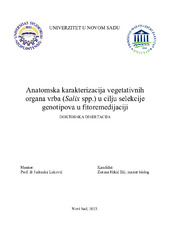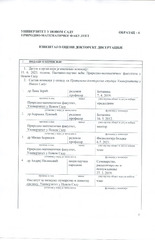Приказ основних података о дисертацији
Anatomska karakterizacija vegetativnih organa vrba (Salix spp.) u ciljuselekcije genotipova u fitoremedijaciji
Anatomical characterization of the willow (Salix spp.) vegetative organs forselection of genotypes in the phytoremediation
| dc.contributor.advisor | Luković, Jadranka | |
| dc.contributor.other | Zorić, Lana | |
| dc.contributor.other | Luković, Jadranka | |
| dc.contributor.other | Borišev, Milan | |
| dc.contributor.other | Pilipović, Andrej | |
| dc.creator | Хркић Илић, Зорана | |
| dc.date.accessioned | 2023-10-04T13:57:44Z | |
| dc.date.available | 2023-10-04T13:57:44Z | |
| dc.date.issued | 2023-09-29 | |
| dc.identifier.uri | https://www.cris.uns.ac.rs/DownloadFileServlet/Disertacija168906945703461.pdf?controlNumber=(BISIS)130767&fileName=168906945703461.pdf&id=21870&source=NaRDuS&language=sr | sr |
| dc.identifier.uri | https://www.cris.uns.ac.rs/record.jsf?recordId=130767&source=NaRDuS&language=sr | sr |
| dc.identifier.uri | https://www.cris.uns.ac.rs/DownloadFileServlet/IzvestajKomisije168906946924839.pdf?controlNumber=(BISIS)130767&fileName=168906946924839.pdf&id=21871&source=NaRDuS&language=sr | sr |
| dc.identifier.uri | https://nardus.mpn.gov.rs/handle/123456789/21727 | |
| dc.description.abstract | Vrbe (Salix spp.) imaju značajnu ulogu u fitoremedijaciji potencijalno toksičnih elemenata i organskih polutanata. Podaci o anatomskim i hidrauličkim osobinama vegetativnih organa vrba pod uticajem Cd su malobrojni ili uopšte nisu dostupni. Da bi se identifikovali genotipovi vrba koji imaju visok potencijal primjene u projekttima fito(dendro)remedijacije kadmijuma, tri klona Salix alba L. klon ‘B-44’, Salix viminalis L. klon ‘SV068’ i Salix matsudana Koidz. klon ‘SM4041’ gajena su metodom zemljišnih kultura u prisustvu kadmijuma sa ili bez dodatka limunske kiseline. Anatomskom analizom su utvrđene genotipske specifičnosti u parametrima vegetativnih organa, idrauličnoj teorijskoj provodljivosti ksilema korijena, reznice i izbojka i otpornosti na kavitaciju i embolizam. Definisane su intergenotipske varijabilnosti kvantitativnih karaktera nadzemnih i podzemnih segmenata reznica, adventivnih korijenova, izbojaka i liski odabranih klonova vrba, koje imaju značaj u potpunijem poznavanju anatomske građe vrsta iz roda Salix. Stereološka analiza pružila je nove, do sada nepoznate podatke o volumenskim gustinama izbojaka vrba. Anatomskom analizom vegetativnih organa klonova vrba izvršenom u tri faze tokom rasta biljaka, utvrđeno je postojanje intergenotipskih razlika na anatomskom planu u zavisnosti od reakcija na tretmane Cd i Cd u prisustvu limunske kiseline i dužine trajanja tretmana, tj. Faze uzorkovanja. Zapažene varijacije kvantitativnih parametara vegetativnih organa mogu biti polazna tačka u programima selekcije genotipova vrba koji se gaje i istražuju za različite primjene, uključujući selekciju genotipova sa poboljšanim nivoom rasta daptabilnosti i otpornosti na faktore stresa, uključujući povećane koncentracije potencijalno toksičnih elemenata u zemljištu, vodi i vazduhu. Na osnovu dobijenih podataka karakteristike traheja i hidrauličke osobine ksilema su identifikovani kao anatomskih parametri povezani sa mehanizmima tolerancije, akumulacije i translokacije elemenata u vegetativnim organima vrba i imaju ulogu svojevrsnog vodiča u produkciji i selekciji genotipova najpogodnijih za fitoekstrakciju i fitostabilizaciju. Rezultati ove disertacije pokazuju da se među analiziranim genotipovima vrba, klon 'B-44' ističe kao genotip sa svojstvima poželjnim za fitostabilizaciju, a klonovi 'SV068' i 'SM4041' za fitoekstrakciju kadmijuma. Dodavanje limunske kiseline zemljištu kontaminiranog Cd može se smatrati poželjnom i dgovarajućom mjerom dendroremedijacije, koja doprinosi povećanju usvajanja i akumulacije Cd u vegetativnim organima odabranih klonova vrbe, a samim tim i efikasnijem uklanjanju Cd iz zagađenog zemljišta. | sr |
| dc.description.abstract | Willows (Salix spp.) have a significant role in the phytoremediation of potentially toxic elements and organic pollutants. Data on the anatomical and hydraulic properties of the vegetative organs of willows under the influence of Cd are few or not available at all. To identify willow genotypes that have a high potential for application in cadmium phyto(dendro)remediation projects, three clones, Salix alba L. clone 'B-44', Salix viminalis L. clone 'SV068' and Salix matsudana Koidz. clone 'SM4041' were cultivated by the method of soil culture in the presence of cadmium with or without the addition of citric acid. Anatomical analysis determined genotypic specificities in the parameters of vegetative organs, hydraulic theoretical conductivity of the xylem of root, cutting and shoot and resistance to cavitation and embolism. Intergenotypic variability of quantitative characters of aboveground and underground segments of cuttings, adventitious roots, shoots and leaves of selected willow clones are defined, which have significance in a more complete knowledge of the anatomical structure of species from the genus Salix. Stereological analysis provided new, so far unknown data on the volume densities of willow shoots. By the anatomical analysis of the vegetative organs of willow clones carried out in three phases during plant growth, intergenotypic differences on the anatomical plane are found, depending on reactions to treatments with Cd and Cd in the presence of citric acid and the duration of treatments, i.e. sampling phases. Determined variations of the quantitative parameters of vegetative organs may be the starting point in the programs of the selection of willow genotypes that are grown and investigated for a variety of applications, including genotype selection with improved levels of growth, adaptability, and resistance to stress factors, including increased concentrations of potentially toxic elements in soil, water and air. Based on the obtained data, vessels characteristics and hydraulic properties of the xylem are identified as the anatomical parameters associated with the mechanisms of tolerance, accumulation and translocation of elements in the vegetative organs of willows and have the guiding role in the production and selection of genotypes most suitable for phytoextraction and phytostabilization. The results of this dissertation show that among the analyzed willow genotypes, clone 'B-44' stands out as a genotype with properties desirable for phytostabilization, and clones 'SV068' and 'SM4041' for cadmium phytoextraction. The addition of citric acid to the soil contaminated with Cd can be considered a desirable and appropriate measure of dendroremediation, which contributes to an increased adoption and accumulation of Cd in the vegetative organs of selected willow clones, and therefore more effective removal of Cd from polluted soil. | en |
| dc.language | sr (latin script) | |
| dc.publisher | Универзитет у Новом Саду, Природно-математички факултет | sr |
| dc.rights | openAccess | en |
| dc.source | Универзитет у Новом Саду | sr |
| dc.subject | Salix | sr |
| dc.subject | Salix | en |
| dc.subject | clone | en |
| dc.subject | cadmium | en |
| dc.subject | citric acid | en |
| dc.subject | anatomy | en |
| dc.subject | stereology | en |
| dc.subject | dendroremediation | en |
| dc.subject | klon | sr |
| dc.subject | kadmijum | sr |
| dc.subject | limunska kiselina | sr |
| dc.subject | anatomija | sr |
| dc.subject | stereologija | sr |
| dc.subject | dendroremedijacija | sr |
| dc.title | Anatomska karakterizacija vegetativnih organa vrba (Salix spp.) u ciljuselekcije genotipova u fitoremedijaciji | sr |
| dc.title.alternative | Anatomical characterization of the willow (Salix spp.) vegetative organs forselection of genotypes in the phytoremediation | en |
| dc.type | doctoralThesis | sr |
| dc.rights.license | Attribution-NonCommercial-ShareAlike | |
| dc.identifier.fulltext | http://nardus.mpn.gov.rs/bitstream/id/153711/Disertacija_14078.pdf | |
| dc.identifier.fulltext | http://nardus.mpn.gov.rs/bitstream/id/153712/Izvestaj_komisije_14078.pdf | |
| dc.identifier.rcub | https://hdl.handle.net/21.15107/rcub_nardus_21727 |



